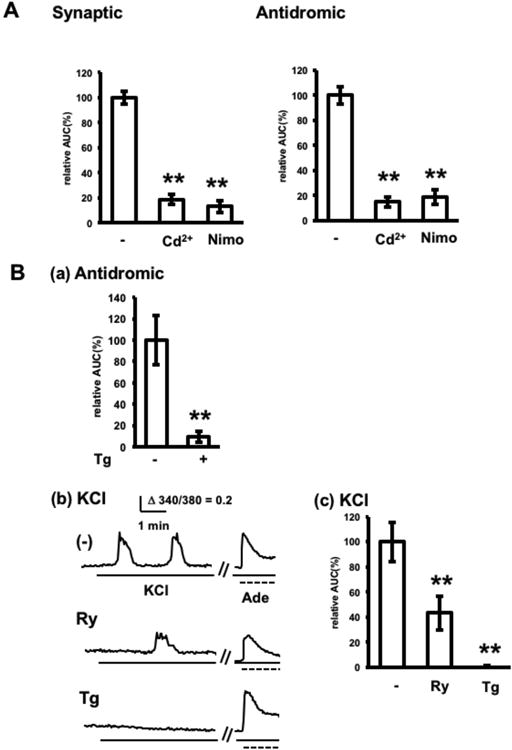Figure 4.

Involvement of L-type calcium channels and CICR in electrically-induced adenosine release. A. Pharmacologic inhibition of calcium channels. Adenosine release in response to synaptic or antidromic stimulation in the absence or presence of 100 μM Cd2+ (pretreatment; 10 min) or 50 μM nimodipine (Nimo, pretreatment; 30 min). n= 23–30 cells from 3–4 experiments, **p < 0.01, Dunnett's multiple comparison test with control. B. Pharmacologic inhibition of CICR. (a) Adenosine release by normal and thapsigargin-treated (Tg, 1 μM) slices in response to antidromic stimulation. Slices were treated with 1 μM thapsigargin for 15 min, washed three times with normal aCSF, and placed onto adenosine sensor cells in normal aCSF for electrical stimulation. n= 30 cells from 3 experiments, **p < 0.01, t-test. (b) Effects of ryanodine and thapsigargin on adenosine release in response to KCl stimulation. Representative calcium increases in adenosine sensor cells. Adenosine release was induced by bath application of KCl (final concentration, 25 mM) as indicated by solid lines, and the lack of effect of ryanodine and thapsigargin on the adenosine response of adenosine sensor cells was confirmed by bath applications of adenosine (final concentration, 10 μM) at the end of the experiment (dashed line). Ryanodine treatment (Ry, 20 μM) was started 30 min prior to KCl stimulation. Thapsigargin was used as in Fig 4B(a). (c) Average KCl-induced calcium increases in adenosine sensor cells in the presence or absence of ryanodine or thapsigargin. Each n= 30 cells from 3 experiments, **p < 0.01, Dunnett's multiple comparison test with control.
